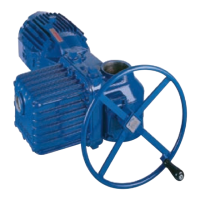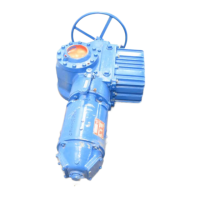71
Limitorque QX Electronic Actuator FCD LMENIM3306-06 – 07/14
flowserve.com
4.20.4 Custom Input Mode #2 – Momentary ESD/CSE (Optional)
Custom software is available for the QX that permits the user to establish certain performance characteristics
momentary contact closure ESD and 4-wire remote control.
NOTE: These three inputs are normally configurable, however, when this custom mode is enabled, they are set to the
predefined configuration and cannot be changed by the customer.
Input 0 (normal default – ESD) terminal 30:
• Set as remote stop
Input 1 (normal default – Open Inhibit) terminal 34:
• Set as remote close
Input 2 (normal default – Close Inhibit) terminal 35:
• Set as remote open
NOTE: These three inputs are the normal open-close-stop inputs. When this custom mode is enabled, they are set to
the predefined configuration and cannot be changed by the customer. The only change the customer can make is to set
the momentary ESD action (if action is position – then also the target value for the ESD).
Input 3 (normal default – Stop) terminal 26:
• Set as enabled, ESD release function, signal absent = active
Input 4 (normal default – Open) terminal 25:
• Set as enabled, ESD Release function, signal present = active
Input 5 (normal default – Close) terminal 27:
• Set as enabled, momentary ESD function, signal present > 800 ms = active, ESD action = Close.
The ESD release signals are setup as redundant signals for safety. There are two signal inputs, and BOTH must be in the
active state. If there is an active ESD and both ESD release inputs are in the active state, the ESD will be unlatched and
the unit will return to normal operation. If the ESD release inputs are in a fault state, an active ESD will NOT be released.
The ESD release inputs will have no effect on a partial stroke ESD test. The momentary ESD input will be ignored if
there is a present for less than 100 ms, and is guaranteed to latch in the ESD if the signal is present for greater than 800
ms. Once the ESD is latched in, the unit will perform the ESD action. In this case the ESD will move the unit to the close
limit and remain in ESD mode until the ESD release indication is given using the ESD release inputs.
4.20.5 Custom Input Mode #3 – ESD Time Delay Relay
Custom software is available for the QX that permits the User to establish certain performance characteristics for ESD.
NOTE: These three inputs are normally all configurable. However, when this custom mode is enabled, the customer still
retains the ability to change inputs 1 and 2 to their choosing, but Input 0 will always remain ESD. The timer is default
0-30 min (30 sec increment with default 0 sec).
Input 0 (normal default – ESD) terminal 30:
• Set as enabled, ESD, 0 sec Delay(default), Signal present = active, ESD action Close
Input 1 (normal default – Open Inhibit) terminal 34:
• Set as enabled, User Input, Signal present = active
Input 2 (normal default – Close Inhibit) terminal 35:
• Set as enabled, User Input, Signal present = active
The ESD Time Delay Relay input (input 0) functions like any normal ESD input signal. Only if a time has been entered
into the Delay Timer value then the unit will not act on that ESD for that delayed amount of time. If the ESD signal is

